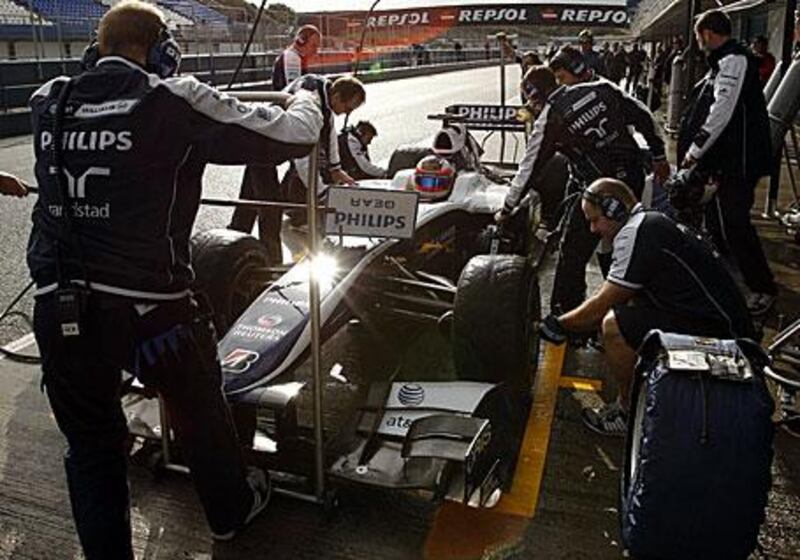The last month of testing was supposed to answer a lot of questions ahead of the Formula One season: Who is the quickest? Who has missed a trick on a car design? Who is looking the best for the championship? But four Spanish test sessions, staged in Jerez, Valencia and Barcelona, have brought more intrigue rather than answers as the teams prepare for the opening race in Bahrain on March 14. The top teams all looked remarkably close in Sunday's final day of testing in Barcelona, with seven tenths of a second covering the top eight drivers and seven teams.
With the majority of them all working on qualifying simulation runs, therefore on low fuel, it gave a fair glimpse at the raw pace of the cars and confirmed that there is genuinely not much between them. Lewis Hamilton, the 2008 champion, took the honours on the last day for McLaren-Mercedes with a time of 1min 20.472secs, but only by less than a tenth of a second from Mark Webber's Red Bull-Renault and the Ferrari of Felipe Massa. Michael Schumacher's Mercedes GP car was only a further three tenths of a second off that pace and the four teams expected to fight for race victories and the title this year look well matched.
But with Adrian Sutil's Force India-Mercedes, Rubens Barrichello's Williams-Cosworth and the BMW-Sauber of Kamui Kobayashiall in the 1.20 bracket as well, it seems that this will be another genuinely competitive year of action. It was noteworthy that none of the teams were talking up their chances after Sunday. There may be a hint of gamesmanship from some who are reluctant to declare their hand, but it is probably the case that no-one really knows where they actually stand in relation to the rest of the field. Ferrari have looked consistently impressive throughout the month, but Massa said: "I'm satisfied with the whole of testing, not just Barcelona.
"Valencia and Jerez too - we did what we wanted to do, but it looks like it will be a very tough and competitive championship. "We never expected to have an advantage and to go to the first race and win in an easy way, definitely not. We expect to have a competitive car, and this I think we have done. The car is reliable, but also consistent, and that is what we want to start the season." Not exactly earth-shattering stuff from the Brazilian. Reading between the lines he is essentially saying: "We are quick, but others are fast too and we know it is going to be close".
Schumacher, back in the sport after three years away and whose return led to unparalleled interest from media and fans in testing, was equally reticent when discussing his hopes of a winning on his comeback to Formula One. The seven-times world champion said: "We have some improvement [for Bahrain], but is it much or is it not compared with what the others may or may not do? It's a puzzle that's difficult to read."
That last sentence sums up a lot of things about testing for 2010, as it simply is not just about the raw one-lap pace anymore. With no refuelling, the cars have to run on Sundays now fat with fuel and that puts a lot of pressure on tyre and brake conservation. Previously the longest a car would normally run for in a race would be up to 35 laps so the fuel tank was smaller and thus it was easier to compare the pace of different cars as was their little window for trying something different.
But now with the fuel tanks being more vast, the teams have been experimenting on different fuel loads as they try and work on predicting how their car will handle when heavy and when light for the 19-race season. This has led to a greater disparity in lap times with, for instance, Red Bull being two seconds faster than McLaren on some days, only for them to be three seconds adrift of Ferrari the next day.
Fascinating but equally unfathomable when trying to work out who actually has the advantage and it will not be until qualifying on March 13 that an accurate picture will start to emerge. At the back, Lotus and Virgin Racing, two of the new teams on the grid, have been, on average, five or more seconds off the pace and they will undoubtedly both face a tough baptism to the sport. But at least they are going to be there. A major doubt hangs over Campos Meta, who have Bruno Senna in their ranks. They have not tested at all. Even if they do somehow make it to Bahrain, they are going to be spectacularly off the pace. US F1 appears to be dead in the water, with no funding, no mechanics, no car and only one driver. The first race of the season is always eagerly anticipated, but with more questions than answers emerging from testing, the action in Sakhir will, more so than ever, provide a useful barometer of what lies ahead. gcaygill@thenational.ae





